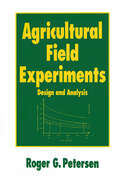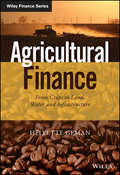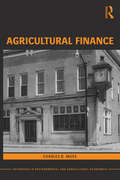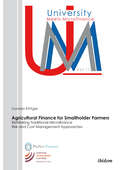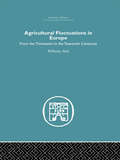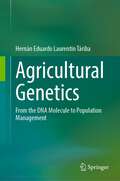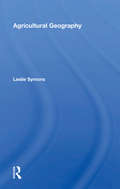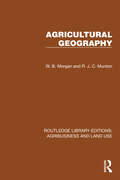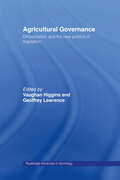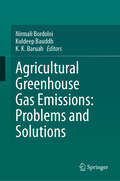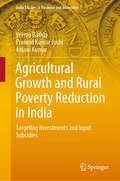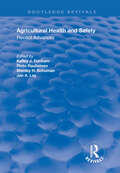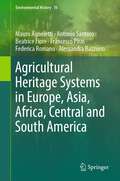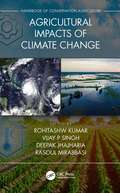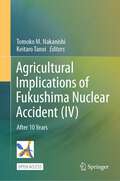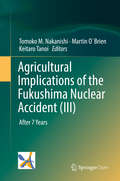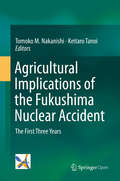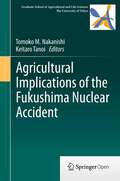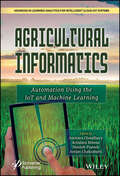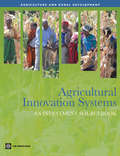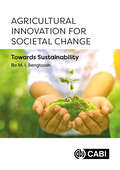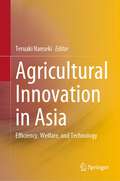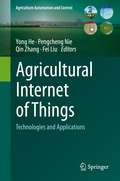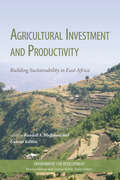- Table View
- List View
Agricultural Field Experiments: Design and Analysis (Books in Soils, Plants, and the Environment #Vol. 31)
by Roger G. PetersenThis text provides statistical and biometrical procedures for designing, conducting, analyzing and interpreting field experiments. It addresses the most important research topics in agriculture, including agronomy, breeding and pasture trials; farming systems research; and intercropping research.
Agricultural Finance
by Helyette GemanA comprehensive resource for understanding the complexities of agricultural financeAgricultural Finance: From Crops to Land, Water, and Infrastructure is a pioneering book that offers a comprehensive resource for understanding the worldwide agriculture markets, from spikes in agricultural commodity prices to trading strategies, and the agribusiness industry generally to the challenges of feeding the planet in particular. The book also goes in-depth on the topics of land, water, fertilizers, biofuels, and ethanol. Written by Helyette Geman--an industry expert in commodity derivatives--this book explores the agricultural marketplace and the cycles in agricultural commodity prices that can be the key to investor success.This resource addresses a wide range of other important topics as well, including agricultural insurance, energy, shipping and bunker prices, sustainability, investments in land, subsidies, agricultural derivatives, and farming risk-management. Other topics covered include structured products and agricultural commodities ETFs; trade finance in an era of credit shortage; securitization and commodity-linked notes; grains: wheat, corn, soybeans; softs: coffee, cocoa, cotton; shipping as a key component of agricultural trade; and the major agricultural shipping routes and the costs. The book:Offers the first comprehensive resource that deals with the all aspects of agricultural financeIncludes information that is crucial for pension funds, asset managers, hedge funds, agribusiness corporates, CTAs and regulatorsCovers a range of topics from agricultural bunker prices, futures, options to major shipping routes and the costsThis text is a must-have resource for accessing the information required to trade successfully in the agricultural marketplace.
Agricultural Finance (Routledge Textbooks in Environmental and Agricultural Economics)
by Charles B. MossThis textbook integrates financial economics and management in the area of agricultural finance. The presentation of financial economics discusses how the credit needs of farmer/borrowers are met by depositors through commercial banks. The financial management content presents methods used to make farm financial decisions including farm accounting, capital budgeting, and the analysis of risk. The textbook begins by developing the farm financial market focusing primarily on the market for debt. Next, the textbook presents an overview of accounting concepts important for the credit market. The accounting section provides a detailed discussion of the Farm Financial Standards Council’s suggestions for agricultural financial statements. Following the financial accounting, the book presents the use of ratio analysis applied to the farm firm. Next, the text describes capital budgeting followed by an introduction to risk analysis. Finally, the book presents the effect of debt decisions on the farm firm. In addition to the primary topics, the textbook includes a discussion of agricultural banking and monetary policy and an analysis of the choice of historical cost and market valued accounting methodologies on the farm debt decision.
Agricultural Finance for Smallholder Farmers: Rethinking Traditional Microfinance Risk and Cost Management Approaches (University Meets Microfinance #11)
by Daniela RöttgerEven though traditional microfinance has successfully paved the way for offering financial services to low-income populations without traditional collateral, many microfinance institutions (MFIs) are still reluctant to move into rural areas and agricultural finance, due to the perceived high risks and costs. Daniela Röttger's research demonstrates how MFIs can mitigate risks and costs of lending to smallholder farmers by using a combination of proven traditional microfinance mechanisms while adapting specific loan features and lending mechanisms to the particularities of smallholder agriculture. <P><P>She systematically compares traditional microfinance risk management mechanisms with agricultural microfinance approaches and identifies successful strategies. Eight MFIs providing agricultural finance to smallholder farmers in four countries in East and West Africa (Uganda, Kenya, Benin, Cameroon) were interviewed and their loan features and agricultural lending mechanism were analyzed. The study shows that MFIs can successfully serve smallholder farmers in rural areas. A strong commitment combined with sound in-house knowledge of agricultural value chains and the flexibility to adapt loan terms and lending procedures to the particularities of agriculture are needed to successfully develop and sustain agricultural microfinance.
Agricultural Fluctuations in Europe: From the Thirteenth to twentieth centuries
by Wilhelm AbelWilhelm Abel's study of economic fluctuations over a period of seven hundred years has long been established as a core text in European agricultural history. Professor Abel was one of the first economic historians to make extensive use of statistical data, and his scholarship and approach have had a decisive effect on the orientation of economic and agricultural history. Using data on population, wages and rents from England, France, Germany and the Low Countries, and, on occasion, from Italy, Scandinavia and Poland, here Professor Abel demonstrates the striking similarity in the overall economic development for all these areas. He also analyses, the short-term fluctuations that have affected agricultural development within this economic framework, and is able to show the broad significance of the shape of the late medieval depression, the scale of the desertions of villages that accompanies it, and the implications of the sixteenth century price revolution. The book's importance lies in tracing the long-term trends that have characterized European economic development since the High Middle Ages, and as such it has made an invaluable contribution to all comparative analyses of different Western European countries since it was first published in 1980.
Agricultural Genetics: From the DNA Molecule to Population Management
by Hernán Eduardo Laurentin TáribaReaders will find in this book a comprehensive text on the intersection of genetic and agriculture, addressing the different levels at which DNA is studied for agricultural purposes. The different subdivisions of genetics (molecular, Mendelian, quantitative and populations) are all discussed in the light of agriculture research and practice. Agricultural Genetics aims to be a support for advanced and undergraduate students taking courses on biology, genetics and breeding applied to agriculture, both for plant sciences and animal sciences.
Agricultural Geography
by Leslie SymonsThis book provides a historical summary of agricultural development and representative ways in which agricultural production is undertaken in different social, economic and physical environments. It describes concepts and methodology for understanding any area or type of farming.
Agricultural Geography (Routledge Library Editions: Agribusiness and Land Use #19)
by W. B. Morgan R. J. MuntonOriginally published in 1971, this book is a systematic study of the major features and factors of the location and distribution of global agricultural enterprises. Special emphasis is given to approaches to the subject developed by economists and economic geographers, but all aspects of agricultural geography are reviewed including physical environmental problems. An introduction to the problem of classification and data collection together with instruction in some simple analytical techniques is given to equip the student with the basic methods for their own research.
Agricultural Governance: Globalization and the New Politics of Regulation (Routledge Advances in Sociology)
by Geoffrey Lawrence Vaughan HigginsFood security and sustainability are arguably the most important issues facing the agri-food sector at the beginning of a new millennium. In an era of globalization, where nation states appear to have a diminishing role in governing these matters, the existing and emerging power relations underpinning agri-food regulation demand renewed scholarly attention. Drawing upon the expertise of some of the most prominent writers in rural sociology, geography and anthropology, this book shows how globalization processes open up a new regulatory politics in which ‘non-political’ forms of governing play an increasingly influential role in shaping agricultural production and consumption. The first of its kind to critically and comprehensively examine new forms of governing and regulation, this important text explores the relationship between globalization and new sites, spaces and agents of agricultural regulation, using detailed case studies in developed nations to illustrate points made. Demonstrating the political significance of regulatory mechanisms extending beyond the state, the book also discusses the consequences for the governing of the agri-food sector.
Agricultural Greenhouse Gas Emissions: Problems and Solutions
by Kuldeep Bauddh Nirmali Bordoloi K. K. BaruahThis book collects information on greenhouse gas (GHG) emissions, especially from the agro-ecosystems. It highlights the GHG emission mitigation measures using environmentally viable and cost-effective technologies. The title deals with the evaluation of the emission of GHGs from different agriculture sources, estimates the emission trends, analyzes the affecting drivers and assesses the feasible and suitable mitigation options for local farmers. Agricultural activities including land clearing, crop cultivation, fertilizer application, irrigation pattern, animal husbandry and fisheries have a significant impact on GHG production and emissions. The application of excess amount of inorganic fertilizer to increase the crop production may also boost the emissions of GHGs from agricultural fields. Therefore, it is urgent to concurrently quantify the fluxes of GHGs, improve understanding of gaseous emissions from different agricultural sources and to develop mitigation strategies to reduce the future climate chaos. This book is of interest to the farmers, horticulturists, scientists, ecologists, and a valuable source of reference to the relevant researchers and students in the region. Also, the book serves as additional reading material for undergraduate and graduate students of environmental science, agriculture, animal husbandry, ecology and soil science.
Agricultural Growth and Rural Poverty Reduction in India: Targeting Investments and Input Subsidies (India Studies in Business and Economics)
by Seema Bathla Pramod Kumar Joshi Anjani KumarThis book provides a blueprint for the allocation of public expenditures “in” and “for” agriculture at the dis-aggregated state level and suggests a reorientation in favour of disadvantaged regions where the marginal returns on additional investments would be higher. It provides insights into the inter-linkages between public expenditures, private investment, rural poverty, and agriculture productivity from a regional perspective to reflect upon spatial differences in the welfare effects of various investments, subsidies, and policies. The book focuses on agricultural growth and rural poverty reduction through public and private investments, non-farm employment, and other pathways to the formulation of appropriate policies at the dis-aggregated state level. It presents new evidence based on advanced econometric tools for analysing and understanding the relationship between public and private investments in agriculture and input subsidies (fertilizer, power, irrigation, and credit) together with their impacts at the dis-aggregated state level. The book also deliberates on an income based direct support system for farmers as an alternative to the existing input price subsidy regime. Accordingly, the book offers valuable insights not only for researchers working on poverty alleviation, rural economy, and agricultural growth, but also for policymakers.
Agricultural Growth, Productivity and Regional Change in India: Challenges of globalisation, liberalisation and food insecurity (Routledge Studies in the Modern World Economy)
by Surendra Singh Prem ChhetriAgriculture productivity, growth and regional change in post-colonial India from a spatial perspective are yet to be rigorously examined. In particular, the impacts of economic liberalisation, globalisation and deregulation are not being empirically investigated at a small-area level using advanced statistical and spatial techniques. Understanding the process of regional formation and the rapid transitioning of agricultural landscapes in the Post-Liberalisation phase is pivotal to developing and devising regional economic development strategies. This book employs advanced methods to empirically examine the key characteristics and patterns of regional change in agricultural growth and productivity. It offers insights on changes in agricultural production and practices since the colonial period through to the Post-Liberalisation phase in India. It also incorporates the key public policy debates on the progress of India’s agricultural development with the aim of formulating spatially integrated strategies to reduce rapid rise in the regional convergence and to promote equitable distribution of strategic government investment.
Agricultural Health and Safety: Recent Advances
by Kelley J. Donham Risto Rautiainen Stanley H Schuman Jan LayProtect yourself from machinery accidents, skin cancer, pesticide exposure, and so much more!Maintaining safety on the farm is a greater challenge than ever. Farmers are trying to expand their farm size and increase production while coping with labor shortages, adverse weather, and equipment problems. Agricultural Health and Safety gives you an in-depth look at these issues and presents effective new approaches to intervention and education for farm health and safety problems. Agricultural Health and Safety discusses new research, education, and prevention programs that have been tested from Maine to California and from Australia to Sweden. These important scientific and analytical studies were presented at the 1996 National Institute for Occupational Safety and Health Conference in Iowa. In addition to suggesting new ways to deal with the recognized physical hazards of farming, Agricultural Health and Safety discusses the often neglected role of mental health. It examines the role of stress in causing accidents and the risks of depression and suicide among agricultural workers. Agricultural Health and Safety considers a broad range of problems and effective interventions, including: insurance incentives for safe farms accident-prevention programs training for responding to farm emergencies cutting the risks of accident for farm children the ergonomics of milking teaching farm youth about sun safety the risks of exposure to pesticides, fertilizers, and other environmental hazardsAgricultural Health and Safety offers practical information on the broad spectrum of health and safety hazards in the farm setting and outlines effective strategies for eliminating them. In addition, it opens new avenues for further study and research. This comprehensive book is an essential resource for agricultural safety and health researchers, program professionals, health care providers in farming communities, professors and students in agromedicine and agricultural programs, and agricultural workers.
Agricultural Heritage Systems in Europe, Asia, Africa, Central and South America (Environmental History #16)
by Mauro Agnoletti Antonio Santoro Beatrice Fiore Francesco Piras Federica Romano Alessandra BazzurroAgriculture is often considered as one of the main threats to ecosystems. Unsustainable farming practices often result in habitat loss, inefficient use of water, soil degradation, pollution, genetic erosion, among other negative impacts on human life, including hunger, low food quality, reduced access to food resources, as well as the abandonment of rural areas. Nevertheless, when agriculture is practiced in a sustainable way, it can contribute to the preservation of many habitats, to the protection of watersheds, to the preservation and improvement of soil health.The use of sustainable and ecological practices is the key feature distinguishing traditional agriculture from intensive one. It may not provide very high yields, but ensures sustainable harvests over time, thanks to time-tested technologies and traditional know-hows and also represent examples of adaptation to harsh environmental conditions. Based on this approach, in 2002, FAO launched the concept of Globally Important Agricultural Heritage Systems (GIAHS) Programme, to identify and safeguard agricultural systems that are ensuring food and livelihood security, while maintaining magnificent landscapes, agricultural biodiversity, traditional knowledge, cultural and social values.This book presents 18 examples of these traditional agriculture systems around the world, with a special focus on Europe, Asia, Africa, Central and South America, as a result of the “GIAHS Building Capacity” project co-funded by the Italian Agency for Development Cooperation (AICS) and carried out by the Department of Agriculture, Food, Environment and Forestry (DAGRI) of the University of Florence (Italy).
Agricultural Impacts of Climate Change [Volume 1]
by Vijay P. Singh Rohitashw Kumar Deepak Jhajharia Rasoul MirabbasiConservation agriculture is a sustainable production model that not only optimizes crop yields, but also reaps economic and environmental benefits as well. The adoption of successful conservation agriculture methods has resulted in energy savings, higher organic matter content and biotic activity in soil, increased crop-water availability and thus resilience to drought, improved recharge of aquifers, less erosion, and reduced impacts from the weather associated with climate change in general. Agricultural Impacts of Climate Change examines several important aspects of crop production, such as climate change, soil management, farm machinery, and different methods for sustainable conservation agriculture. It presents spatial distribution of a daily, monthly and annual precipitation concentration indices, Diffuse Reflectance Fourier Transform Infrared Spectroscopy for analyzing the organic matter in soil, and adaptation strategies for climate-related plant disease scenarios. It also discusses solar energy-based greenhouse modeling, precision farming using remote sensing and GIS, and various types of machinery used for conservation agriculture. Features: Examines the effects of climate change on agriculture and the related strategies for mitigation through practical, real-world examples Explores innovative on-farm technology options to increase system efficiency resulting in improved water usage Presents examples of precision farming using climate-resilient technologies
Agricultural Implications of Fukushima Nuclear Accident (IV): After 10 Years
by Keitaro Tanoi Tomoko M. NakanishiThis open access book presents the findings from on-site research into radioactive cesium contamination in various agricultural systems affected by the Fukushima Daiichi Nuclear Power Plant accident in March 2011. This fourth volume in the series reports on studies undertaken at contaminated sites such as farmland and forests, focusing on soil, water, mountain, agricultural products, and animals. It also provides additional data collected in the subsequent years to show how the radioactivity levels in agricultural products and their growing environments have changed with time and the route by which radioactive materials entered agricultural products as well as their movement between different components (e.g., soil, water, and trees) within an environmental system (e.g., forests). The book covers various topics, including radioactivity testing of food products; decontamination trials for rice and livestock production; the state of contamination in, trees, mushrooms, and timber; the dynamics of radioactivity distribution in paddy fields and upland forests; damage incurred by the forestry and fishery industries; and the change in consumers’ attitudes. In the series of this book, a real-time radioisotope imaging system has been introduced, a pioneering technique to visualize the movement of cesium in soil and in plants. This is the only book to provide systematic data on the actual change of radioactivity, which is of great value to all researchers who wish to understand the effect of radioactive fallout on agriculture. In addition, it helps the general public better understand radio-contamination issues in the environment. The project is ongoing; the research groups from the Graduate School of Agricultural and Life Sciences of The University of Tokyo continue their work in the field further to evaluate the long-term effects of the Fukushima accident.
Agricultural Implications of the Fukushima Nuclear Accident (III): After 7 Years
by Keitaro Tanoi Tomoko M. Nakanishi Martin O BrienThis open access book presents the findings from on-site research into radioactive cesium contamination in various agricultural systems affected by the Fukushima Daiichi Nuclear Power Plant accident in March 2011. This third volume in the series reports on studies undertaken at contaminated sites such as farmland, forests, and marine and freshwater environments, with a particular focus on livestock, wild plants and mushrooms, crops, and marine products in those environments. It also provides additional data collected in the subsequent years to show how the radioactivity levels in agricultural products and their growing environments have changed with time and the route by which radioactive materials entered agricultural products as well as their movement between different components (e.g., soil, water, and trees) within an environmental system (e.g., forests). The book covers various topics, including radioactivity testing of food products; decontamination trials for rice and livestock production; the state of contamination in, trees, mushrooms, and timber; the dynamics of radioactivity distribution in paddy fields and upland forests; damage incurred by the forestry and fishery industries; and the change in consumers’ attitudes. Chapter 19 introduces a real-time radioisotope imaging system, a pioneering technique to visualize the movement of cesium in soil and in plants. This is the only book to provide systematic data on the actual change of radioactivity, and as such is of great value to all researchers who wish to understand the effect of radioactive fallout on agriculture. In addition, it helps the general public to better understand the issues of radio-contamination in the environment. The project is ongoing; the research groups from the Graduate School of Agricultural and Life Sciences of The University of Tokyo continue their work in the field to further evaluate the long-term effects of the Fukushima accident.
Agricultural Implications of the Fukushima Nuclear Accident: The First Three Years
by Keitaro Tanoi Tomoko M. NakanishiFollowing the Fukushima nuclear accident, a large volume of monitoring data has been collected about the soil, air, dust, and seawater, along with data about an immense number of foods supplied to the market. Little is known, however, about the effect of radioactive fallout on agriculture, information about which is vital. Although more than 80% of the damaged area is related to agriculture, in situ information specifically for agriculture is scarce. This book provides data about the actual movement and accumulation of radioactivity in the ecological system--for example, whether debris deposited on mountains can be a cause of secondary contamination, under what conditions plants accumulate radioactive cesium in their edible parts, and how radioactivity is transferred from hay to milk. Because agriculture is so closely related to nature, many specialists with different areas of expertise must be involved in answering these questions. In the case of rice, researchers in rice cultivation as well as in soil, hydrology, and radioactivity measurement are working together to reveal the paths or accumulation of radioactivity in the field. For this purpose, the Graduate School of Agricultural and Life Sciences of The University of Tokyo has diverse facilities available throughout Japan, including farmlands, forests, and meadowlands. Many academic staff members have formed groups to conduct on-site research, with more than 40 volunteers participating. This book presents the data collected from the only project being systematically carried out across Japan after the Fukushima accident.
Agricultural Implications of the Fukushima Nuclear Accident: The First Three Years
by Keitaro Tanoi Tomoko M. NakanishiFollowing the Fukushima nuclear accident, a large volume of monitoring data has been collected about the soil, air, dust, and seawater, along with data about an immense number of foods supplied to the market. Little is known, however, about the effect of radioactive fallout on agriculture, information about which is vital. Although more than 80% of the damaged area is related to agriculture, in situ information specifically for agriculture is scarce. This book provides data about the actual movement and accumulation of radioactivity in the ecological system—for example, whether debris deposited on mountains can be a cause of secondary contamination, under what conditions plants accumulate radioactive cesium in their edible parts, and how radioactivity is transferred from hay to milk. Because agriculture is so closely related to nature, many specialists with different areas of expertise must be involved in answering these questions. In the case of rice, researchers in rice cultivation as well as in soil, hydrology, and radioactivity measurement are working together to reveal the paths or accumulation of radioactivity in the field. For this purpose, the Graduate School of Agricultural and Life Sciences of The University of Tokyo has diverse facilities available throughout Japan, including farmlands, forests, and meadowlands. Many academic staff members have formed groups to conduct on-site research, with more than 40 volunteers participating. This book presents the data collected from the only project being systematically carried out across Japan after the Fukushima accident.
Agricultural Informatics: Automation Using the IoT and Machine Learning (Advances in Learning Analytics for Intelligent Cloud-IoT Systems)
by Arindam Biswas Amlan Chakrabarti Manish Prateek Amitava ChoudhuryDespite the increasing population (the Food and Agriculture Organization of the United Nations estimates 70% more food will be needed in 2050 than was produced in 2006), issues related to food production have yet to be completely addressed. In recent years, Internet of Things technology has begun to be used to address different industrial and technical challenges to meet this growing need. These Agro-IoT tools boost productivity and minimize the pitfalls of traditional farming, which is the backbone of the world’s economy. Aided by the IoT, continuous monitoring of fields provides useful and critical information to farmers, ushering in a new era in farming. The IoT can be used as a tool to combat climate change through greenhouse automation; monitor and manage water, soil and crops; increase productivity; control insecticides/pesticides; detect plant diseases; increase the rate of crop sales; cattle monitoring etc. Agricultural Informatics: Automation Using the IoT and Machine Learning focuses on all these topics, including a few case studies, and they give a clear indication as to why these techniques should now be widely adopted by the agriculture and farming industries.
Agricultural Innovation Systems
by the editors at The World BankResearch, education, and extension investments, while usually necessary, are often insufficient alone to bring knowledge, technologies, and services that enable farmers and entrepreneurs to innovate. Efforts to strengthen research systems and increase the availability of knowledge have not increased innovation or the use of knowledge in agriculture at the pace or the scale required by the intensifying and proliferating challenges confronting agriculture. Agricultural Innovation Systems: An Investment Sourcebook contributes to the identification, design, and implementation of the investments, approaches, and complementary interventions most likely to strengthen agricultural innovation systems (AIS) and to promote innovation and equitable growth. The Sourcebook provides a menu of tools and operational guidance, as well as good practice lessons, to illustrate approaches to designing, investing in, and improving these systems. Managing the ability of agriculture to meet rising global demand and to respond to the changes and opportunities will require good policy, sustained investments, and innovation—not business as usual. Experience indicates that aside from a strong capacity in R&D, the ability to innovate is often related to collective action and coordination, exchange of knowledge among diverse actors, incentives and resources available to form partnerships and develop business, and an enabling environment. While consensus is developing about what is meant by 'innovation' and 'innovation system,' no detailed blueprint exists for making agricultural innovation happen at a given time, in a given place, for a given result. That said, the AIS approach, which looks at these multiple conditions and relationships that promote innovation in agriculture in specific contexts, has moved from a concept to a subdiscipline with principles of analysis and action. Drawing on approaches that have been tested at different scales in different settings, this Sourcebook emphasizes the lessons learned, benefits and impacts, implementation issues, and prospects for replicating or expanding successful practices. The Sourcebook reflects the experiences and evolving understanding of numerous individuals and organizations concerned with agricultural innovation, including the World Bank. It targets the key operational staff who design and implement lending projects in international and regional development agencies and national governments, as well as the practitioners who design thematic programs and technical assistance packages. The Sourcebook can also be an important resource for the research community and nongovernmental organizations.
Agricultural Innovation for Societal Change: Towards Sustainability
by Dr Bo Malte BengtssonOver the centuries, agriculture has developed through technological steps illustrated by various agricultural revolutions. This book describes and analyses significant agricultural changes since the mid-1960s in the context of development, innovation and adoption by revisiting resource-poor farmers in Ethiopia, Sweden and Trinidad and Tobago, and considering overall development changes up to the early 2020s. It is a platform for discussing current issues for future global food security in the context of globalization and free global trade which have influenced economic growth in many countries but also created environmental concerns and a rapid increase in the number of transnational corporations (TNCs). Sustainable food production is now a global priority and therefore ecological footprints must be reduced - this book provides examples of possible technical changes required to achieve this. Reducing greenhouse gas emissions alone is insufficient: political attention must be paid to declining biodiversity, the increasing global exploration of natural resources, demography, increased consumption, waste mountains, expanding migration and antibiotic resistance. Agribusiness TNCs will challenge national governments and international donors in both research and development, increasing competition for leadership. A gradual societal change, incorporating an understanding of biological fundamentals, is necessary for achieving sustainability and for leading us towards the next agricultural revolution.
Agricultural Innovation in Asia: Efficiency, Welfare, and Technology
by Teruaki NansekiThis book covers the major findings of almost all types of innovation in agriculture that includes product and process innovation, marketing and organizational innovation, and extended to institutional changes and social welfare in agricultural innovation in Asia. Specially, this book provides the measuring of these types of agricultural innovation on production, economics, and social welfare. Furthermore, this book provides the overview of smart farming in two advanced countries in Asia in this field, which are China and Japan along with its innovation. This book also aims to give an overview on the development of agricultural innovation in the era of digital agriculture over the world.
Agricultural Internet of Things: Technologies and Applications (Agriculture Automation and Control)
by Fei Liu Qin Zhang Yong He Pengcheng NieInternet of things (IoT) is a new type of network that combines communication technology, expanded applications, and physical devices. Among them, agriculture is one of the most important areas in the application of the IoT technology, which has its unique requirements and integration features. Compared to the information technology in traditional agriculture, the agricultural IoT mainly refers to industrialized production and sustainable development under relatively controllable conditions. Agricultural IoT applies sensors, RFID, visual capture terminals and other types of sensing devices to detect and collect site information, and with broad applications in field planting, facility horticulture, livestock and poultry breeding, aquaculture and agricultural product logistics. It utilizes multiple information transmission channels such as wireless sensor networks, telecommunications networks and the internet to achieve reliable transmission of agricultural information at multiple scales and intelligently processes the acquired, massive information. The goals are to achieve (i) optimal control of agricultural production process, (ii) intelligent electronic trading of agricultural products circulation, and (iii) management of systematic logistics, quality and safety traceability. This book focuses on three levels of agricultural IoT network: information perception technology, information transmission technology and application technology.
Agricultural Investment and Productivity: Building Sustainability in East Africa
by Randall Bluffstone Gunnar K�hlinAgricultural Investment and Productivity provides a deep and systematic look at the opportunities for and constraints to investments in sustainable agriculture in East Africa, offering important insights into what works and how to analyze agricultural investments in one of the poorest regions of the world. The book critically examines the reasons behind East Africa's stagnant agricultural productivity over the past forty-five years, using the primary lens of investments in fertilizers, seeds, and sustainable land management technologies, These investments have a tremendous impact on production volume, ultimately affecting the income of millions of families throughout the region.
